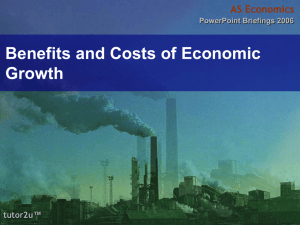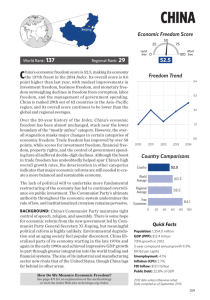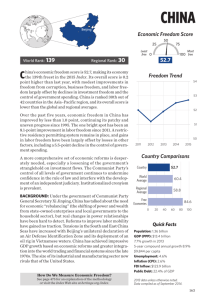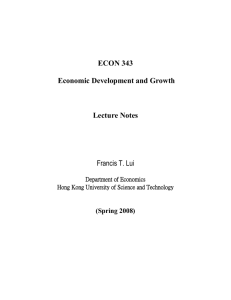Africa`s Infrastructure:
advertisement
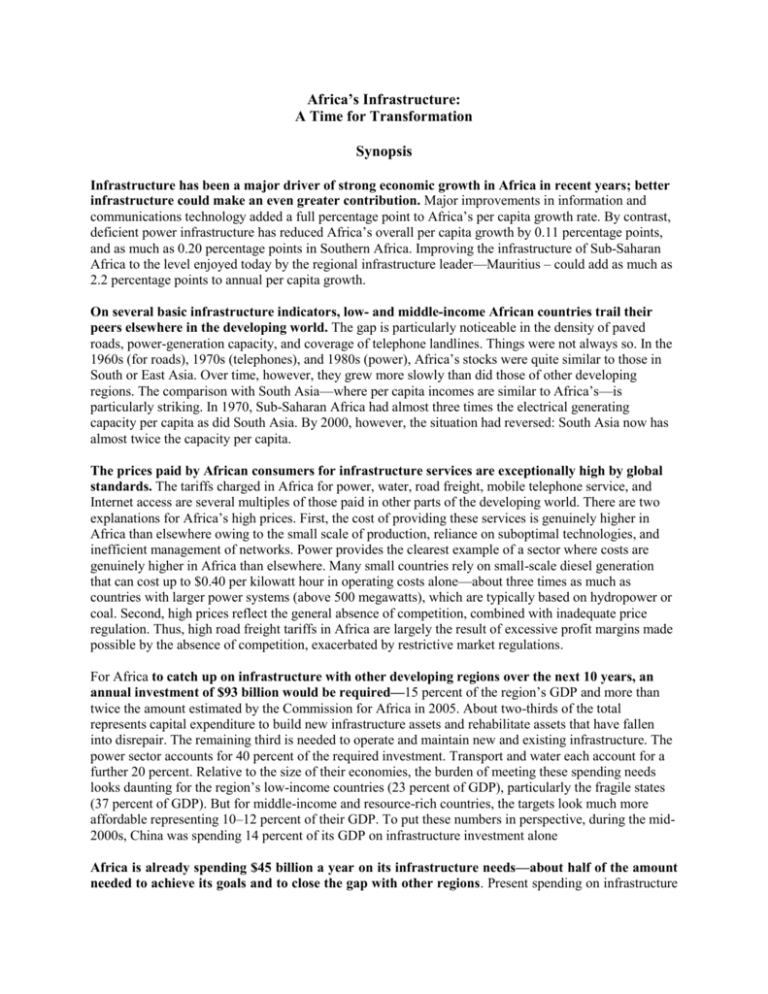
Africa’s Infrastructure: A Time for Transformation Synopsis Infrastructure has been a major driver of strong economic growth in Africa in recent years; better infrastructure could make an even greater contribution. Major improvements in information and communications technology added a full percentage point to Africa’s per capita growth rate. By contrast, deficient power infrastructure has reduced Africa’s overall per capita growth by 0.11 percentage points, and as much as 0.20 percentage points in Southern Africa. Improving the infrastructure of Sub-Saharan Africa to the level enjoyed today by the regional infrastructure leader—Mauritius – could add as much as 2.2 percentage points to annual per capita growth. On several basic infrastructure indicators, low- and middle-income African countries trail their peers elsewhere in the developing world. The gap is particularly noticeable in the density of paved roads, power-generation capacity, and coverage of telephone landlines. Things were not always so. In the 1960s (for roads), 1970s (telephones), and 1980s (power), Africa’s stocks were quite similar to those in South or East Asia. Over time, however, they grew more slowly than did those of other developing regions. The comparison with South Asia—where per capita incomes are similar to Africa’s—is particularly striking. In 1970, Sub-Saharan Africa had almost three times the electrical generating capacity per capita as did South Asia. By 2000, however, the situation had reversed: South Asia now has almost twice the capacity per capita. The prices paid by African consumers for infrastructure services are exceptionally high by global standards. The tariffs charged in Africa for power, water, road freight, mobile telephone service, and Internet access are several multiples of those paid in other parts of the developing world. There are two explanations for Africa’s high prices. First, the cost of providing these services is genuinely higher in Africa than elsewhere owing to the small scale of production, reliance on suboptimal technologies, and inefficient management of networks. Power provides the clearest example of a sector where costs are genuinely higher in Africa than elsewhere. Many small countries rely on small-scale diesel generation that can cost up to $0.40 per kilowatt hour in operating costs alone—about three times as much as countries with larger power systems (above 500 megawatts), which are typically based on hydropower or coal. Second, high prices reflect the general absence of competition, combined with inadequate price regulation. Thus, high road freight tariffs in Africa are largely the result of excessive profit margins made possible by the absence of competition, exacerbated by restrictive market regulations. For Africa to catch up on infrastructure with other developing regions over the next 10 years, an annual investment of $93 billion would be required—15 percent of the region’s GDP and more than twice the amount estimated by the Commission for Africa in 2005. About two-thirds of the total represents capital expenditure to build new infrastructure assets and rehabilitate assets that have fallen into disrepair. The remaining third is needed to operate and maintain new and existing infrastructure. The power sector accounts for 40 percent of the required investment. Transport and water each account for a further 20 percent. Relative to the size of their economies, the burden of meeting these spending needs looks daunting for the region’s low-income countries (23 percent of GDP), particularly the fragile states (37 percent of GDP). But for middle-income and resource-rich countries, the targets look much more affordable representing 10–12 percent of their GDP. To put these numbers in perspective, during the mid2000s, China was spending 14 percent of its GDP on infrastructure investment alone Africa is already spending $45 billion a year on its infrastructure needs—about half of the amount needed to achieve its goals and to close the gap with other regions. Present spending on infrastructure in Africa is higher than previously thought, once off-budget spending (including state-owned enterprises and extra-budgetary funds) and external financing (aid and private participation in infrastructure) are taken into account. Strikingly, about two thirds of spending is domestically financed, coming from the pockets of African taxpayers and consumers. Some countries already spend more than enough in some infrastructure sectors to cover the needs identified. More efficient use of existing resources could release an additional $17.4 billion in finance for infrastructure each year. The many inefficiencies that blight the use of infrastructure resources today could greatly reduced or even eliminated by suitable policy and institutional reforms. The largest potential gains ($8 billion a year) are to be had by addressing operating inefficiencies through better road maintenance and greater efficiency at power utilities. The second-largest potential gain ($4.2 billion a year) would come from raising user charges for infrastructure services (accompanied by well-targeted subsidies for those unable to pay for basic services). Better pricing of power would produce the greatest dividends. The next-largest saving ($3.3 billion a year) is to be had through better allocation of existing resources across sectors, as resources are transferred from areas that appear overfunded to those that are clearly underfunded. Finally, raising budget-execution ratios through improvements in the public expenditure framework could capture a further $1.8 billion a year. Even if the full potential for efficiency gains were realized, a substantial infrastructure funding gap of $31 billion a year would remain. About three-quarters of that gap relates to capital spending; the remainder, to operations and maintenance. The power sector accounts for about $23 billion of the gap; water supply and sanitation, a further $11 billion per year. Once potential efficiency gains are taken into account, no funding gap was found for ICT and transport, except in fragile states. The nonfragile lowincome countries as a group face a shortfall of 9 percent of GDP, and the fragile states fall short by an insurmountable 25 percent. Regardless of the size of the gap, raising more funds without also tackling inefficiencies would be like pouring more water into a leaking bucket. Bridging both the efficiency gap and the funding gap is vital for economic prosperity in Africa. Raising more funds will be challenging in the context of the current global financial crisis. External finance for Africa’s infrastructure was buoyant in the years leading up to the global financial crisis of 2008/09, swelling from $4 billion in 2002 to $20 billion in 2007. Over the same period, domestic public finance in many countries also benefited substantially from strong economic growth and high prices for natural resources. However, the current global financial crisis is likely to arrest that growth, reducing the funds available for infrastructure financing while also checking demand for infrastructure services. To make ends meet, many countries may have to consider other ways of aligning infrastructure targets with the available resource envelope. One option is simply to give themselves more time to meet the goals. By prolonging the time horizon for meeting infrastructure targets from 10 years to 15, 20, or even 30 years, most countries could meet infrastructure targets within their present budget envelope— but only if efficiency is improved—otherwise the delays would be very much longer. Another option is to look for more cost-effective infrastructure solutions. By adopting lower-cost technologies that allow more people to be served more quickly, substantial savings are achievable for some types of infrastructure. For example, in the case of water and sanitation, the cost of achieving the Millennium Development Goals adopted in 2000 drops by 30 percent with greater reliance on lower-cost technologies, such as public standposts and improved latrines in place of household connections and flush toilets. In tight budget environments, policy makers face a difficult choice between the level of service and the number of people who can be served.

